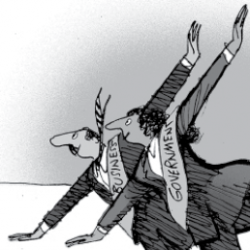This issue's articles are available below.
ELI Members may login to read and download current and past issues of the Forum.
Not a member? Join now!

LEAD FEATURE The Trump administration succeeded in reducing environmental criminal enforcement. Given decades of partisan infighting and under-investment, it could have been worse had not dedicated staff maintained organizational responsibilities and professional duties.
With SIDEBARs by two law firm practitioners with roots in criminal environmental enforcement: Steve Solow and Justin Savage.

CENTERPIECE Internationally, human rights and environmental protection have largely evolved as separate systems, with different standards and obligations. Can a new UN council resolution joining the two branches succeed with aspiration rather than enforcement?
With a SIDEBAR by Sumudu Atapattu, University of Wisconsin Law School.

COVER STORY Filling the gap created by the absence of federal legislation, businesses with growing climate change commitments can join with U.S. government initiatives to form powerful public-private partnerships that will accelerate carbon reductions.
With SIDEBARs by two experts on the business-government nexus: Avi Garbow and Bob Perciasepe.

PROFILE EPA Assistant Administrator Radhika Fox speaks on her journey to water, the historic infrastructure law investments, and her team’s approach to managing the country’s most essential resource.

Methane is over 80 times more effective than carbon dioxide at trapping heat in the atmosphere, making reducing emissions crucial to slowing climate change. But satellite technologies pinpoint tens of thousands of methane sources—from oil and gas wells, to natural gas pipelines, to livestock feedlots, to landfills. We ask experts from a range of backgrounds: How can we come up with the best policies to foster innovation and cut methane from such a variety of sources?
The SEC Steps Toward the Full Monty on Corporate Climate Risk Disclosures
Old Dry-cleaners: Better Regulation Would Not Require More Science
Local Governments Tackle Energy Efficiency of Rental Properties
Performing at the Speed of Science Yields Complex Covid-19 Vaccine
It Is Time to Talk About the Biden Administration’s Record in Court
Legal Issues Dominate Intersection of Climate and Energy Transition
Valuing Pollution Reductions in Premature Mortality Risk Cuts
Climate ‘Madness’: Public Finance Abetting Gas and Oil in Suriname
On a Lawyer and the Disenfranchised
Unspoken Security Dimensions to Nuclear Power
Institute Published Guide on Restoring Wetlands
Providing Tools for Equitable Brownfield Revitalization
On ELI's Programs at Stockholm +50